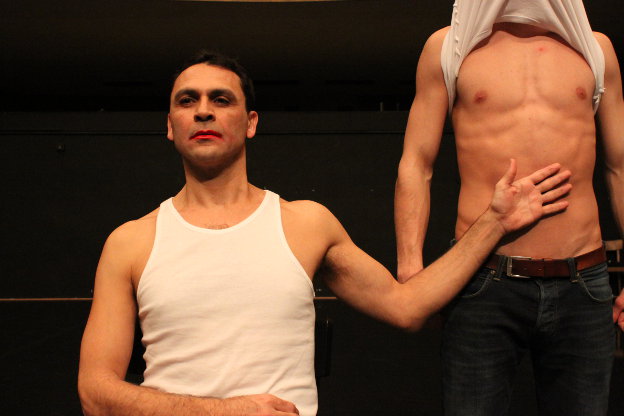The German artist Paul Klee famously said that ‘drawing is taking a line for a walk’. This simple statement hones in on the essence of form, its freedom and vitality a part of the organic process of creation. Receiving its UK premiere as part of Physical Fest 2013, Daphnis Kokkinos’ physicality in his first solo show, Addio Addio Amore, recalled Klee’s conviction on account of the coherence of gesture and the fluency of the dancer’s ideas. Kokkinos is a member of Tanztheater Wuppertal, the company founded by the iconic dancer and choreographer Pina Bausch, and the qualities manifested in this performance hail unmistakably from this stable. The show began with handmade film footage of a field trip to India on which Kokkinos joined other company members and Bausch herself – for a number of years Kokkinos was Bausch’s assistant. Before he entered the stage, the audience watched images of villagers washing dishes on the edge of a river. Such apparently mundane actions were gradually transformed upon repeated viewing into a series of beautiful gestures possessed of their own striking form. Little wonder, then, that Bausch undertook these field trips as if to plumb the world for a repertoire of gestures which would undergo transformation in the rehearsal studio.
Kokkinos appears at the edge of the stage dressed in a suit and holding flowers. He remains silent as the film footage rolls. It’s an image that announces the performance as an active homage to his revered mentor. Naturally enough, memory of Bausch is embedded in muscle memory, andAddio Addio Amore references the iconic grammar of Tanztheater Wuppertal’s method as the palette for a largely autobiographical work. Kokkinos referenced moments from his childhood in Crete and from more recent times with Bausch within a structure composed of imagistic vignettes. In one story Kokkinos tells of sharing the same bed as his older brother and being woken up by grunting coming from under the bedclothes. Both performer and audience were inevitably on the same wavelength here, and the story was a source of much knowing laughter; but while Kokkinos resists looking under the covers eventually he surrenders in order to confirm the inevitable. However, his brother had all the time been doing sit-ups! Kokkinos exploits the moment, not to mention the laughter, when he invites a good-looking male from the audience to do sit-ups, asking him to grunt into a microphone as he does so. Later on, Kokkinos runs through the audience and in and out of the auditorium to depict his mother’s frantic search for the family dog Aphrodite. The clarity of this action is beautiful – pantomimic, even. In the middle of all this running he performs a flirtatious shoulder dance for another unsuspecting audience member.
Coquetry was the source of much genuine comedy in Addio Addio Amore. The man who did the sit-ups was asked again to direct a flirtatious dance straight from the old days of Moulin Rouge to a woman in the audience. A handsome male objectified for the entertainment of women? A queer discourse ran subtly through the piece: the idea that dance forms can be ascribed to gender is a result of patriarchal convention and has little to do with the body’s fitness for this or that type of movement. Kokkinos drew on the trope of participation as he prepared for his next section, and the sense of others filling time for him was deftly balanced with commentary on what it meant to direct and be directed. It’s as if the framework of the show as an homage to Bausch could do little to avoid exploring the subtle power relations underlying the mentor-protégé relationship.
Addio Addio Amore’s form and movement were invigorating but never ostentatious. Kokkinos’ material had been selected with a view to its natural integrity, as in the moment we are told about an old lady who walked the streets of his childhood home bent-double without a walking aid. This image captivated the young Kokkinos, and he imagined the poor old lady lying in bed in the improbable selfsame position. Kokkinos’ observational methods are surely influenced by Bausch’s experimentation, reminding one of John Cage, who said that music was all around us if only we had ears. The same claim can be made about our vision and movement. From the villagers washing dishes in India to the Cretan invalid, Addio Addio Amore drew upon such striking physiognomies as the basis for some choreographic alchemy.

